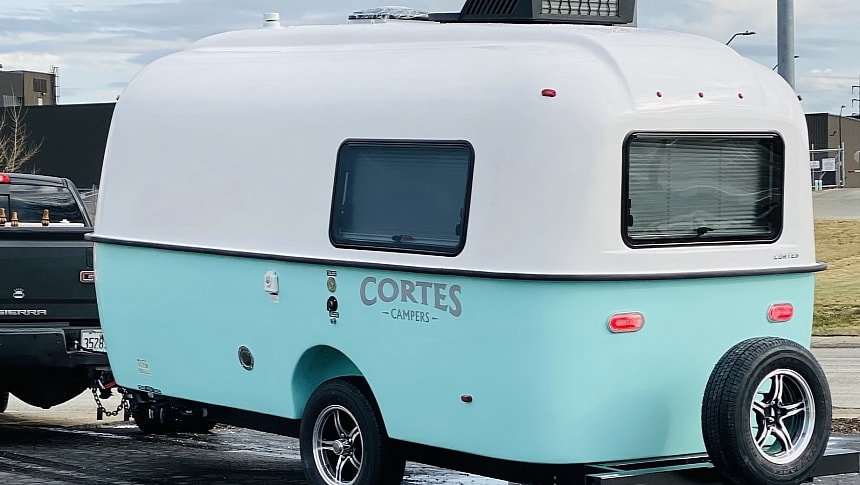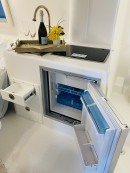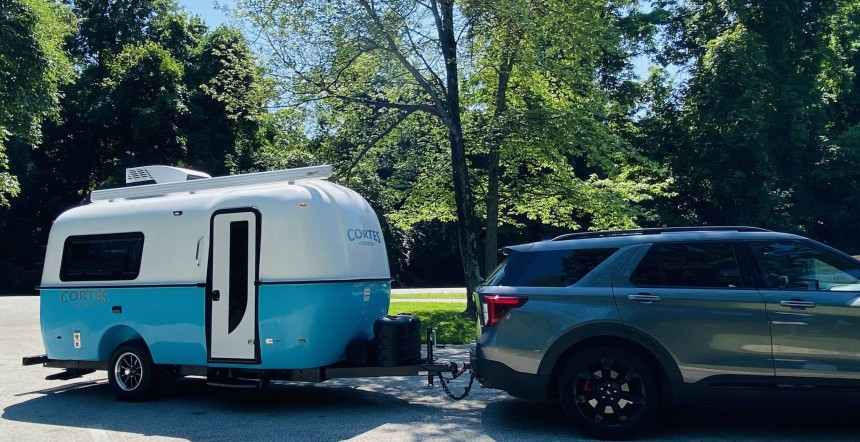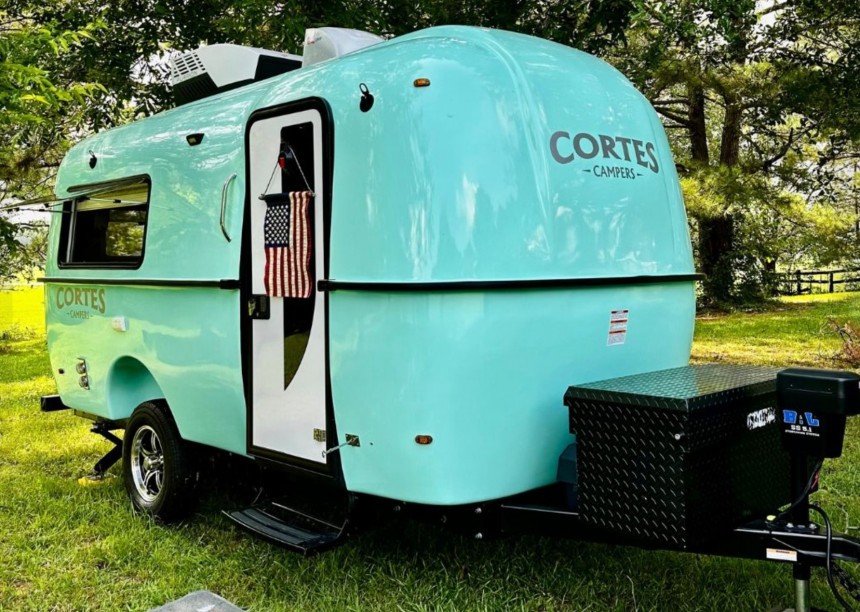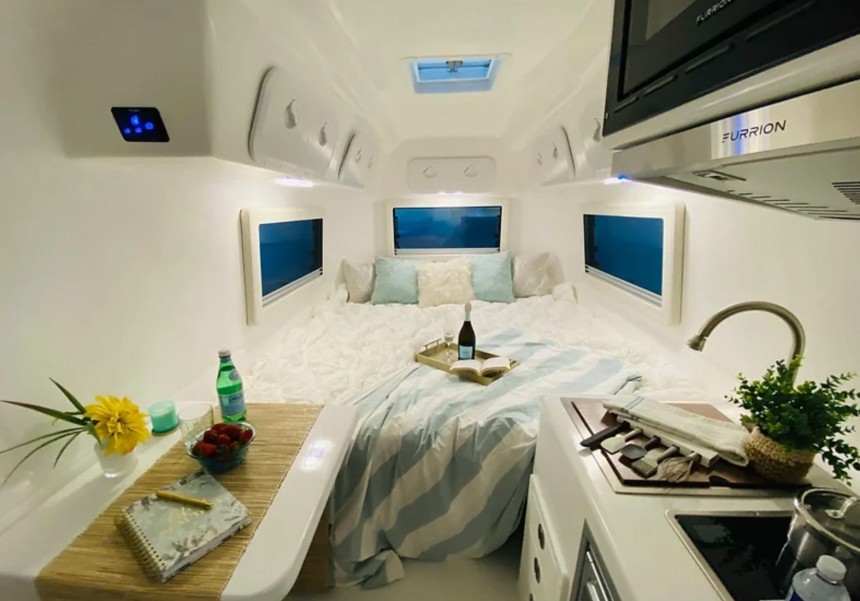Recent years have seen an explosion in fiberglass camper manufacturers. Well, this time around, we take a look at one of the newest teams to sprout up, Cortes Campers, and their take on these timeless habitats.
Folks, if you grew up during the 70s, then you might remember the Boler camper craze that originated in Canada, where it had been brewing since the 60s. If you don't, lucky you, because recent years have seen a resurfacing in this camper style, and countless manufacturers are from right here in the US.
One of these teams is Cortes Campers, a little-known brand that popped up just a couple of years ago. But what most people don't know is that this fiberglass RV manufacturer is actually part of a company born back in 2003, US Lighting Group. We'll talk more about them in a later article.
As for Cortes, we'll be exploring their smallest available unit, the 16, which, surprisingly enough, gives folks like you and me the possibility to live off-grid and to do so comfortably, clean, well-fed, and relaxed to the max.
Now, kicking things off for this unit, let's explore its shell. As I mentioned, this puppy appears to be crafted in the spirit of Boler campers, and considering that technology has surely advanced in the 60 years since their appearance, we can expect these babies to be as fresh as possible, and they are, but with a touch of retro.
One neat trait of the 16 and other Cortes units is that they're crafted with a double-hull design. Not only are there two halves - a top and a bottom one - that create an outer shell, but inside, yet another two hulls are present, and in between, a honeycomb core. All that results in a unit that is suitable for year-round use.
Yet, another effect of this whole double-hull idea really shines through once we step inside this unit. Why? Well, if you've had a look at the images in the gallery, you surely noticed that the interior is basically all crafted from one piece. Even furnishings and features like the bathroom and storage bays overhead are integrated into the mold.
As we enter the unit, to the right, we'll find a wet bath with all the features we need to keep clean and light, while a closet is also present for your essentials. Straight ahead, a galley block provides things like a two-burner top, microwave, sink and flowing water, and a fridge/freezer combo.
To the left of the entrance, a little two-person table is spotted, but toward the rear of the unit, yet another dinette is found, suitable for quite a number of guests. However, once the sun sets and night rolls around, this dinette will take the shape of a beam-to-beam king bed capable of accommodating three guests.
Beyond all that, the manufacturer's website mentions very little regarding what may be found as standard. Tank heaters, a 19-inch TV, a propane furnace, a sound system, and an awning are part of the mix, and so are a pair of marine batteries. Other than that, there are just a few details about the construction process. Oh, and a dry unit weighs 2,220 lbs (1,007 kg).
All this leads me to believe that any other features I haven't mentioned are sure to be optional, so by the time you're done looking at a completed unit, you'll have dished out some extra cash. The question is: just how much cash is all this mobile and retro fun going to cost us?
Well, as I explored Cortes and how they like to do business, I realized that you'd have to work with a dealership to get your hands on a new unit. Searching for a 2024 floorplan, I realized that the price you pay will depend heavily upon what other extras are in place, so expect to pay around $45K (€41,500 at current exchange rates) for a new 16.
Now, some of us would argue that this is quite a bit to pay for a camper; I would disagree, simply because of what we're buying. First of all, fiberglass campers have been found in working order after 50 or more years. Sure, those units were loved, but why wouldn't you care for yours?
Next, we need to consider that the 16 is a year-round camper, and with a bit of attention to the suspension, I'm sure you'll be able to extend just how far into the wild you can venture. You will need to look into solar panels at one point.
As I mentioned, recent years have seen an explosion in fiberglass habitats, and honestly, this trend is showing no signs of slowing down. Notable teams include Trillium, Scamp, nuCamp, and several others. Heck, even Cortes themselves have a few upcoming units in store, and some of them target a very rather market: pickup trucks. Looking for a new camper that you might be able to pass on to your kids?
One of these teams is Cortes Campers, a little-known brand that popped up just a couple of years ago. But what most people don't know is that this fiberglass RV manufacturer is actually part of a company born back in 2003, US Lighting Group. We'll talk more about them in a later article.
As for Cortes, we'll be exploring their smallest available unit, the 16, which, surprisingly enough, gives folks like you and me the possibility to live off-grid and to do so comfortably, clean, well-fed, and relaxed to the max.
One neat trait of the 16 and other Cortes units is that they're crafted with a double-hull design. Not only are there two halves - a top and a bottom one - that create an outer shell, but inside, yet another two hulls are present, and in between, a honeycomb core. All that results in a unit that is suitable for year-round use.
Yet, another effect of this whole double-hull idea really shines through once we step inside this unit. Why? Well, if you've had a look at the images in the gallery, you surely noticed that the interior is basically all crafted from one piece. Even furnishings and features like the bathroom and storage bays overhead are integrated into the mold.
To the left of the entrance, a little two-person table is spotted, but toward the rear of the unit, yet another dinette is found, suitable for quite a number of guests. However, once the sun sets and night rolls around, this dinette will take the shape of a beam-to-beam king bed capable of accommodating three guests.
Beyond all that, the manufacturer's website mentions very little regarding what may be found as standard. Tank heaters, a 19-inch TV, a propane furnace, a sound system, and an awning are part of the mix, and so are a pair of marine batteries. Other than that, there are just a few details about the construction process. Oh, and a dry unit weighs 2,220 lbs (1,007 kg).
All this leads me to believe that any other features I haven't mentioned are sure to be optional, so by the time you're done looking at a completed unit, you'll have dished out some extra cash. The question is: just how much cash is all this mobile and retro fun going to cost us?
Now, some of us would argue that this is quite a bit to pay for a camper; I would disagree, simply because of what we're buying. First of all, fiberglass campers have been found in working order after 50 or more years. Sure, those units were loved, but why wouldn't you care for yours?
Next, we need to consider that the 16 is a year-round camper, and with a bit of attention to the suspension, I'm sure you'll be able to extend just how far into the wild you can venture. You will need to look into solar panels at one point.
As I mentioned, recent years have seen an explosion in fiberglass habitats, and honestly, this trend is showing no signs of slowing down. Notable teams include Trillium, Scamp, nuCamp, and several others. Heck, even Cortes themselves have a few upcoming units in store, and some of them target a very rather market: pickup trucks. Looking for a new camper that you might be able to pass on to your kids?
